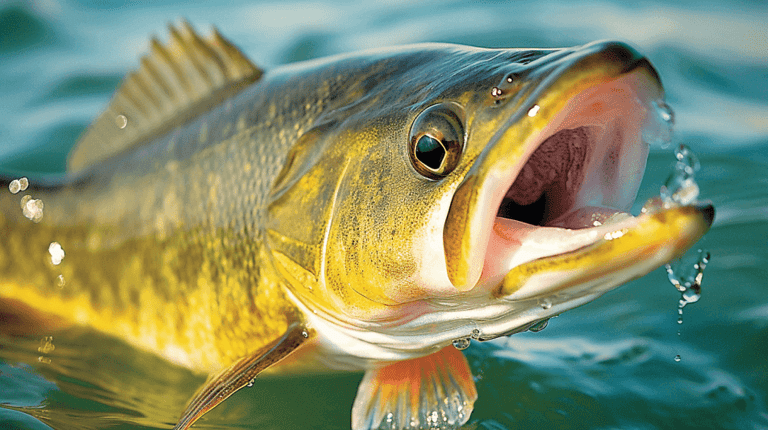Lake Erie’s Underwater Geography and Its Impact on Fishing

Lake Erie’s Underwater Geography and Its Impact on Fishing
You’re casting your line into Lake Erie, not realizing that the lakebed’s contours below are as influential as your bait. The underwater geography, with its varying depths and structures, creates unique habitats that directly impact your fishing success.
You’re navigating more than just water; you’re contending with ridges and troughs that dictate where fish feed, breed, and hide. As seasons shift, so do the areas of low oxygen, known as dead zones, which can push fish into warmer, shallower regions—right where you might be waiting.
Your knowledge of these underwater dynamics isn’t just about landing the big one; it’s crucial for respecting and preserving the lake’s delicate aquatic ecosystem.
So as you reel in your line, remember that you’re experiencing a small piece of a vast, unseen world that’s constantly shaping your fishing journey.
Table of Contents
Key Takeaways
- Lake Erie’s underwater geography, including its varied depths and contours, influences fish distribution and behavior.
- Seasonal hypoxic zones in the central basin of Lake Erie impact the food chain and affect prey and predator species.
- Fish species distribute themselves in response to oxygen levels, with many seeking refuge in shallower, well-oxygenated waters.
- The fishing industry and fishing communities are directly affected by changes in the underwater environment, highlighting the need for data-driven insights and adaptive management strategies.
Lake Erie’s Underwater Geography

Lake Erie’s Bathymetry
You’ll find that Lake Erie’s bathymetry, with its varied depths and contours, plays a critical role in the distribution and behavior of fish species, influencing your fishing success. The lake’s fisheries depend heavily on the interactions between these underwater landscapes and aquatic life.
The western basin, with its shallower depths and higher nutrient influx, presents fertile grounds for fish, promoting a vibrant ecosystem. However, this same fertility can lead to hypoxia, creating dead zones that are inhospitable to fish.
Moving towards the central basin, you encounter deeper waters and a different dynamic. Hypoxic conditions here, particularly during the summer months, force fish to migrate to areas with higher oxygen levels, affecting their accessibility to anglers. This basin’s structure requires a strategic approach to fishing, taking into account the seasonal shifts in oxygen levels.
The eastern basin, being the deepest, offers the coldest conditions, which are preferred by certain species. Yet, even here, the bathymetry influences fish behavior. The presence of hypoxic zones can limit available habitat, compressing fish into smaller areas and potentially increasing your catch rates, provided you can locate these pockets of high fish concentration.
Long-term monitoring of these patterns is essential for sustaining Lake Erie’s fisheries and ensuring continued fishing success.
Seasonal Hypoxic Zones
While you’re considering Lake Erie’s varied bathymetry for your next fishing trip, it’s important to note that the seasonal hypoxic zones can drastically alter where and when fish are available. These low-oxygen areas, primarily caused by harmful algal blooms, result from nutrient runoff leading to excessive plant growth and decomposition. This process consumes oxygen, creating zones unsuitable for most fish and aquatic life, leading to significant habitat degradation.
To understand how these zones affect your fishing prospects, consider the following:
- Spatial Dynamics: Hypoxic zones typically develop in the central basin due to its depth and stratification, causing fish to migrate towards more oxygenated, shallower waters.
- Temporal Variability: The extent of hypoxia can vary within the season; late summer and early fall often experience the most severe hypoxia, affecting the availability of species like rainbow smelt and emerald shiner.
- Impact on Species: Water quality declines due to hypoxia impact the food chain, with prey species relocating or declining in numbers, which in turn affects predator species such as walleye.
These factors underscore the importance of continuous monitoring and research to maintain a sustainable fishery in Lake Erie. Effective management of nutrient inputs and water quality is critical to mitigating the formation of seasonal hypoxic zones.
Fish Species Distribution
Considering the seasonal hypoxia, you’ll find that fish species in Lake Erie distribute themselves in response to oxygen levels, with many seeking refuge in shallower, well-oxygenated waters. This spatial shift significantly impacts fish biomass distribution patterns, particularly for species like yellow perch, which are integral to commercial catch figures. Analyzing data from long-term monitoring, researchers have documented a correlation between hypoxic events and altered fish distributions, with some species exhibiting reduced abundance in hypoxic zones.
Lake Erie’s fish species distribution isn’t merely a response to oxygen availability. It also reflects the broader ecological interactions within the lake, including predation and competition for resources. For instance, the availability of prey such as rainbow smelt and emerald shiner can drive the movement of larger predator species like walleye, which are highly sought after by both recreational and commercial fisheries.
To maintain the lake’s productive fisheries, it’s crucial to continue data-driven management practices. This involves assessing the impact of hypoxic conditions on fish species distribution and adjusting fishing quotas and conservation strategies accordingly. The economic health of the region’s fishing industry hinges on a nuanced understanding of these underwater dynamics.
Fishing Industry Effects
As a fisherman on Lake Erie, you’re directly impacted by the lake’s underwater geography, which affects the availability and behavior of key species, influencing both your catch and livelihood. The underwater geography, particularly in western Lake Erie, shapes the distribution of prey fish and, subsequently, the dynamics of Lake Erie’s fisheries.
Here’s how the underwater geography affects the fishing industry:
- Bottom Hypoxia: Seasonal hypoxia in certain areas alters habitat use patterns among prey fish, impacting their availability to predators and, consequently, the largest commercial fishery in Canadian waters focused on yellow perch and walleye.
- Fish Behavior: Variations in underwater structure and depth influence the migration and aggregation of fish, requiring strategic fishing practices to optimize catch rates and maintain a sustainable fishery.
- Economic Impact: Changes in the underwater environment, such as increased hypoxia, can lead to shifts in fish populations that directly affect the economic stability of communities reliant on Lake Erie’s fisheries.
An analytical approach to your fishing strategy involves understanding these technical aspects and adapting to the data-driven insights on fish behavior and population changes. This knowledge is critical for maintaining your role within the complex ecosystem of Lake Erie’s commercial and recreational fishing industries.
Management and Monitoring
Because you’re navigating the complex waters of Lake Erie’s fishing industry, it’s essential that you’re aware of the ongoing management and monitoring efforts that assess and respond to the lake’s underwater geography and its influence on fish populations. State university researchers, in collaboration with the Sea Grant program, are at the forefront of this analytical endeavor.
They deploy a data-driven approach to understand hypoxia’s nuanced impact on key species like rainbow smelt and emerald shiner.
The efforts by these institutions provide critical insights that inform Great Lakes fisheries management strategies. For instance, the data gathered can pinpoint hypoxic zones, facilitating targeted conservation measures. Advanced modeling techniques enable predictions about how shifts in underwater terrain and water quality might affect fish distribution and abundance, allowing for proactive adjustments to fishing regulations and practices.
Moreover, ongoing monitoring is crucial to evaluating the effectiveness of these management actions. It ensures that the policies and interventions aren’t only grounded in solid, empirical evidence but also remain adaptive to the changing conditions of Lake Erie’s underwater landscape. This cyclical process underscores the importance of sustained research and observation in preserving the lake’s vibrant fishing industry for future generations.
Economic Implications
You’ll often find that the shifting underwater terrain of Lake Erie, marked by areas of hypoxia, directly influences the profitability of the local fishing industry. As the University of Michigan’s studies indicate, these hypoxic zones affect fish distribution and health, which in turn impacts economic outcomes.
Here’s how:
- Fish Populations: Hypoxia alters habitat quality, leading to changes in the abundance and distribution of fish like yellow perch and walleye, key to the region’s fishing economy.
- Fishing Yields: Fluctuating fish populations, driven by underwater geography and water quality, directly affect commercial and recreational catch rates, influencing revenue streams for both sectors.
- Legislation and Remediation Costs: Efforts to manage water quality, including the mitigation of hypoxia, result in regulatory changes and potentially significant expenses for local governments and industries, including those in New York.
In a data-driven analysis, the economic implications of Lake Erie’s underwater geography extend beyond immediate fishing yields. They encompass a broader spectrum of regional economic activities, necessitating a careful balance between ecological health and economic vitality. Understanding these dynamics is crucial for stakeholders aiming to sustainably capitalize on Lake Erie’s natural resources.
Future Research Directions
To better protect Lake Erie’s fisheries, you need to support targeted research that clarifies how seasonal hypoxia impacts various fish species’ populations and distributions. This necessitates a data-driven approach, focusing on the zones in Lake Erie where hypoxia is most prevalent. For instance, investigating the long-term effects on key species such as rainbow smelt and emerald shiner, which form the basis of the food web for larger predators like walleye, is crucial.
The United States, which borders much of Lake Erie, has a vested interest in understanding these dynamics to ensure the sustainability of both commercial and recreational fisheries. By deploying an array of sensors and conducting regular fishery surveys, researchers can gather high-resolution data over extended periods of time. This long-term monitoring would provide a robust dataset, enabling the development of predictive models to forecast population changes and migrations in response to fluctuating oxygen levels.
Future research should also dissect the adaptive responses of fish to low oxygen zones, as these insights will inform adaptive management strategies to mitigate adverse effects. With concerted efforts and scientific rigor, you can pave the way for healthier fish populations and a more resilient Lake Erie ecosystem.
Frequently Asked Questions
What Is the Geography of Lake Erie?
You’re examining Lake Erie’s geography, which features a shallow western basin and a deeper eastern basin, with varied topography affecting water temperature and nutrient distribution across the lake.
Why Is Lake Erie so Good for Fishing?
You’re experiencing great fishing in Lake Erie due to its nutrient-rich waters, which sustain diverse, abundant fish populations, despite challenges like hypoxia that require careful management for the industry’s long-term success.
How Does Lake Erie Affect the Environment?
You must consider that Lake Erie influences the environment through nutrient runoff, which fuels algal blooms, affecting water quality and aquatic life, thus demanding stringent conservation efforts to mitigate these environmental impacts.
What Features Make Lake Erie Particularly Susceptible to Water Pollution Compared to the Other Great Lakes?
You’re looking at Lake Erie’s shallow depth, warm temperatures, and nutrient-rich waters, which, along with agricultural runoff and urban waste, heighten its vulnerability to water pollution more than the other Great Lakes.
Conclusion
As you pack up your gear, remember that Lake Erie’s unique bathymetry and seasonal hypoxia directly impact fish distribution, affecting your catch. The fishing industry adapts to these underwater contours and oxygen fluctuations, while management efforts aim to sustain the ecosystem. Economic outcomes hinge on this delicate balance.
Continued research is vital, ensuring future strategies reflect the complex interplay of Lake Erie’s geography and biology. Your fishing success story is entwined with the lake’s intricate underwater world.







One Comment
Comments are closed.